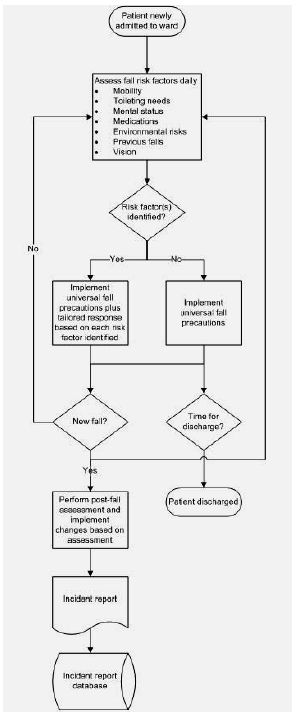Word Version [  - 61.8 KB]
- 61.8 KB]
Background: The purpose of this tool is to provide an overview of how fall prevention care processes could occur at your hospital or hospital unit.
Reference: Developed by Falls Toolkit Research Team.
How to use this tool: Compare the master clinical pathway to your current activities and adapt your activities or the master clinical pathway as needed to suit your specific circumstances.
This tool can be used by the quality improvement manager, staff nurses, and nursing assistants as an aid in designing a new system, as a training tool, or as an ongoing clinical reference tool. This tool can be modified or a new one created to meet the needs of your particular setting. If you prepared a process map describing your current practices, you can compare that with desired practices outlined on the clinical pathway.
Inpatient Falls Clinical Pathway

[D] Text Description: The flowchart starts with patient newly admitted to ward; next is Assess fall risk factors daily (mobility, toileting needs, mental status, medications, environmental risks, previous falls, vision). Next is to identify risk factors. If Yes, implement universal fall precautions plus tailored response based on each risk factor identified. If new fall, perform postfall assessment and implement changes based on assessment; then draft incident report and enter it into incident report database. If not a new fall, go back to assess fall risk factors. If risk factors are not identified, implement universal fall precautions and determine if it is time for discharge. If so, patient is discharged. If universal fall precautions are implemented and a new fall occurs, follow steps for new fall as described.



